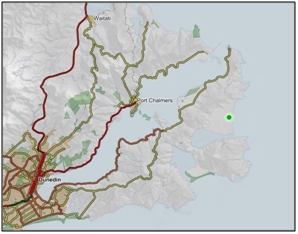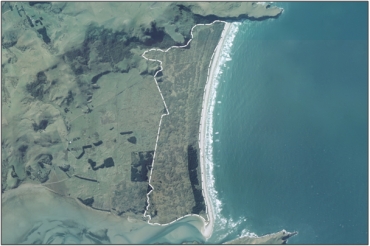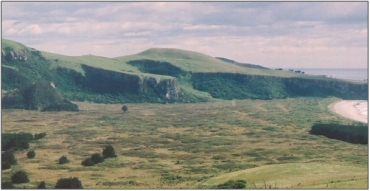Dune hollows (permanently or periodically wet), wetland turf, bogs and ponds within the Okia Reserve, Okia Flat, Otago Peninsula. The best example of dune hollow vegetation in the Otago Coast Ecological Region. 1
-
-
-
-
-
-
-
-
-
-
-
-
-
Okia Flat Wetland Management Area
-
-
-
-
-
-
-
-
-
-
-
-
-
-
-
-
-
-
Okia Flat Wetland Management Area
Description:
Type/Class:
Marsh 2
Size:
220.6 ha.
Altitude:
0-80 m above sea level.
Approximate location:
2.5 km East of the intersection of Dick Road and Weir Road, Portobello.
NZTM (centre point): E1423400 N4922400
Regional Plan: Water for Otago.
Schedule 9 Regionally Significant Wetland, no.115, Map F63
Territorial Authority:
Dunedin City Council.

Recorded Values:
Value |
Description |
|
|---|---|---|
A1 |
|
|
A5 |
|
|
A6 |
|
|
A7 |
|
|
A2-A4, A8, A9 |
No relevant information is currently held by the ORC. |
Other Information:
•Presence of Carex cirrhosa, which has a threat status of nationally vulnerable. “2”
•Other key native wetland species found in 1993 include common twig rush (Baumea rubiginosa), Baumea tenax, Carex dipsacea, rautahi (Carex lessoniana), pūkio (Carex secta), Carex virgata, snow tussock (Chionochloa sp.), red tussock (Chionochloa rubra), sharp spike sedge (Eleocharis acuta), leafless rush/wīwī (Juncus gregiflorus), square sedge (Lepidosperma australe), oioi (Leptocarpus similis) and Sphagnum novo-zelandicum. “49”
•A survey carried out in 2008 found several changes in plant species. Seven species recorded were classified as either nationally threatened or uncommon: sand tussock (Austrofestuca littoralis), Carex cirrhosa, golden sand sedge/Pikao (Desmoschoenus spiralis) and Epilobium chionanthum are all in gradual decline, Drymoanthus flavus is in serious decline, cook’s scurvy grass/heketara (Lepidium oleraceum) is nationally endangered, and fragrant tree daisy (Olearia fragrantissima) is classified as declining. Other indigenous plant species found include common maidenhair (Adiantum cunninghamii), swamp Kiokio (Blechnum minus), starwort (Callitriche petriei), New Zealand broom (Carmichaelia sp.), common mountain daisy (Celmisia gracilenta), Coprosma virescens, Epilobium billardiereanum subsp. Billardiereanum, creeping cudweed (Euchiton involucratus), Euchiton traversii, dwarf bedstraw (Galium perpusillum), māwe (Galium propinquum), prostrate snowberry (Gaultheria macrostigma), marsh gentian (Gentiana grisebachii), Gonocarpus aggregatus, Gonocarpus montanus, Gratiola sexdentata, grass lily (Herpolirion novae-zelandiae), mountain lacebark/houhi (Hoheria angustifolia), Hydrocotyle hydrophila, Hydrocotyle novae -zeelandiae, matted Saint John’s wort (Hypericum japonicum), Isolepis habra, Isolepis inundata, dwarf rush (Juncus antarcticus), dwarf rush (Juncus pusillus) which has a threat status of naturally uncommon, leafless rush (Juncus sarophorus), Lachnogrostis tenuis, papatāniwhaniwha (Lagenifera pumila), common duckweed/kārearea (Lemna minor), poataniwha (Melicope simplex), porcupine shrub (Melicytus alpinus), meadow ricegrass/ pātītī (Microlaena stipoides), ngaio (Myoporum laetum), common water milfoil (Myriophyllum propinquum), water milfoil (Myriophyllum triphyllum), Neopaxia lineariifolia, nertera (Nertera setulosa), kōpata (Pelargonium inodorum), lowland ribbonwood/houi (Plagianthus regius), Hall’s totara/tōtara kōtukutuku (Podocarpus hallii), red pondweed/mānihi (Potamogeton cheesemanii), Pratia perpusilla, Ranunculus glabrifolius, Scandia geniculata, dwarf bog rush (Schoenus maschalinus), Canberra grass/kohukohu (Scleranthus biflorus), cotton fireweed/Pahohoraka (Senecio quadridentatus), small-leaved kowhai/ kōwhai (Sophora microphylla), Triglochin striata, Uncinia leptostachya, white fuzzweed (Vittadinia australis), tree nettle/ongaonga (Urtica ferox) and water meal (Wolffia australiana). “50”
•Eleven of these species are listed in Appendix 16A ‘Threatened Plants present on land within Dunedin City’ and Appendix 16B ‘Important native tree species present on land within Dunedin City’ in the Dunedin City District Plan: red tussock (Chionochloa rubra), Coprosma virescens, mountain lacebark/houhi (Hoheria angustifolia), poataniwha (Melicope simplex), ngaio (Myoporum laetum), fragrant tree daisy (Olearia fragrantissima), lowland ribbonwood/houi (Plagianthus regius), Hall’s totara/tōtara kōtukutuku (Podocarpus hallii), (Scandia geniculata), small-leaved kowhai/ kōwhai (Sophora microphylla) and tree nettle/ongaonga (Urtica ferox). “50”
•Three species of indigenous mammal have been recorded: New Zealand fur seal (Arctocephalus forsteri); southern elephant seal/ihupuku (Mirounga leonine), which has a threat status of nationally critical; and New Zealand sea lion (Phocarctos hookeri), which has a threat status of range restricted. “50”
•Three species of indigenous lizard species and 2 exotic species of frog have been recorded: common gecko (Hoplodactylus maculatus); jewelled gecko (Naultinus gemmeus), which has a threat status of gradual decline; common skink (Oligosoma nigriplantare polychrome); green and golden bell frog; and whistling frog. “50”
•Four species of threatened bird species have been recorded: Yellow-eyed Penguin/Hoiho (Megadyptes antipodes), which is acutely threatened-nationally vulnerable; Blue Penguin (Eudyptula minor) and South Island Rifleman/Titipounamu (Acanthisitta chloris chloris), both with a threat status of gradual decline; and South Island Fernbird/Matata (Bowdleria punctata punctata), which is classified as sparse. Other bird species found at Okia Reserve include; Shining Cuckoo/Pipiwharauroa (Chrysococcyx lucidus lucidus), Australasian Harrier/Kahu (Circus approximans), Grey Warbler (Gerygone igata), Variable Oystercatcher (Haematopus unicolor), Welcome Swallow (Hirundo tahitica neoxena), Southern Black-backed Gull (Larus dominicanus), Swamp Hen/Pukeko (Porphyrio porphyrio melanotus), Paradise Shelduck (Tadorna variegata), Sacred Kingfisher (Halcyon sancta), as well as a number of exotics. “50
”
•A number of pest animals have been recorded. Rabbits are abundant. Possums, cats and mustelids are being controlled. There is some grazing by cattle in the Taiaroa Bush and paddocks in the centre of Okia Flat. “50”
•A number of weed species are present and undergoing weed control. Weed species include blackberry (Rubus sp.), elder (Sambucus nigra), gorse (Ulex europaeus), lupin (Lupinus sp.), macrocarpa (Cupressus macrocarpa), maritime pine (Pinus pinaster), marram grass (Ammophila arenaria), pampas grass, radiata pine (Pinus radiata) and scotch broom (Cytisus scoparius). “50”
•The Ministry of Environment lists Okia Flat as having sections or sites of potential national importance for aquatic biodiversity values. “10”
•Site contains the Pyramids, a significant geological feature. “52”
•A number of moth species are present such as Diasemia grammalis, Pterophorus innotatalis, Arctesthes and Delogenes limodoxa. “52”
•Okia Flat Wetland Management Area is adjacent to the coastal marine area, which is covered by the Regional Plan: Coast for Otago.

Aerial View of Okia Flat Wetland Management Area (March 2006)

Okia Flat Wetland Management Area (2005) “51”
References
1 Otago Regional Council (2004) Regional Plan: Water for Otago. Published by the Otago Regional Council, Dunedin.
2. Ausseil, A.G., Newsome, P., Johnson, P, (2008) Wetland Mapping in the Otago Region. Landcare Research Contract Report prepared for the Otago Regional Council.
10. Ministry for the Environment (2004) Water Programme of Action: Potential Water Bodies of National Importance. Technical working Paper. Published by the Ministry for the Environment, Wellington.
28. Dunedin City Council (1999) Dunedin City District Plan. Published by the Dunedin City Council, Dunedin.
49. Johnson, P.N. (1993b) Okia Flat, Otago Peninsula: Botanical Values and Grazing. Conservation Advisory Science Notes No. 36. Published by the department of Conservation, Wellington.
50. Wildlife Consultants (2008) Ecological Assessment of Okia Reserve, Otago Peninsula. Report No. 2092 prepared for Dunedin City Council, Dunedin.
52. Dunedin City Council (1998) Okia Reserve Management Plan. Dunedin City Council, Dunedin.
